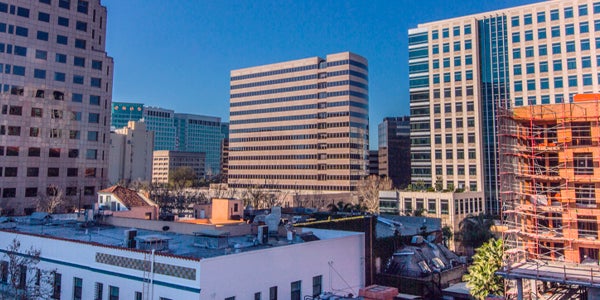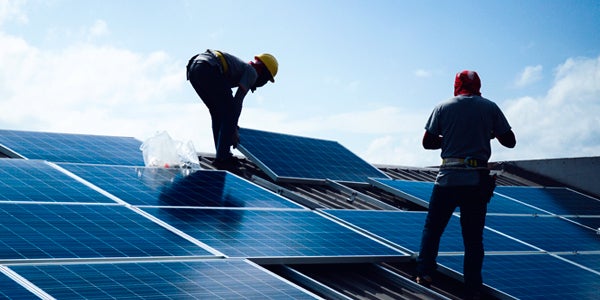With the Biden Administration’s recently signed Infrastructure Investment and Jobs Act (IIJA) coming into law, $1.2 trillion will find its way into many new projects over the next several years. While infrastructure investments won't happen overnight, congressional task forces are hearing bids to allocate funding to the most in-need communities.
Here's what CRE developers need to know now to get a head start.
On November 15, 2021, the Biden Administration signed the Infrastructure Investment and Jobs Act (IIJA) into law. This bipartisan legislation will allocate $1.2 trillion to invest in critical infrastructure projects across the United States, across a number of long-neglected sectors. Planned infrastructure investments include improving roads and bridges, strengthening freight and passenger rail transportation, and bolstering public transportation networks.
IIJA should come with economic improvement for underdeveloped communities, thus increasing property values and attracting new residents. The law's focus on renewable energy and community enhancement will attract new people to blossoming areas. In turn, CRE developers can leverage growing communities in need of commercial space for new businesses and retail.
The package ranges far and wide in its scope, which is good news for CRE developers looking to capitalize on cash infusions. While infrastructure investments won't happen overnight, congressional task forces are hearing bids to allocate funding to the most in-need communities. That $1.2 trillion will find its way into many new projects over the next several years. Here's what CRE developers need to know now to get a head start.

What Is the Significance of the New Infrastructure Investments Bill?
With $1.2 trillion in funding set for distribution over the next ten years, CRE developers should keep a keen eye on where those funds pool. Several federal agencies will act as the middlemen for IIJA funding, but the exact destination for much of the money is currently unknown. We can safely assume that the largest states by population—Texas, California, New York, Florida, Illinois, New Jersey, Pennsylvania, Ohio, Michigan, and Georgia—will receive much of the funding.
CRE Developers should also consider per-capita figures to predict higher percentages of IIJA allocation. States like Alaska, Wyoming, Montana, the Dakotas, West Virginia, and Hawaii are also likely candidates for increased funding. These less-populated states will likely benefit from larger shares of IIJA for federal highway aid. Meanwhile, New England and the Mid-Atlantic (the Acela Corridor) will see more significant public transportation funding. These states have more dense population clusters, and already have extensive infrastructure in place.
Infrastructure investments in all transportation sectors should excite CRE developers about the future. Almost all consumer goods in the US utilize domestic transportation and warehousing in one way or another. IIJA's direct effect on the economy in the form of increased productivity should drive CRE profits for the next decade. Increased productivity means more output, leading to long-term GDP growth.
Preserve and Protect Properties and Infrastructure
Of the $1.2 trillion allocated in IIJA, $47 billion will go towards preserving and refitting communities affected by climate change risks like flooding and wildfires. Due to obvious risk factors, infrastructure investments in these high-climate-risk areas have been historically low. IIJA aims to bolster those markets and inspire CRE developers to invest in those areas confidently.
IIJA allocates billions to the National Oceanic and Atmospheric Administration (NOAA) to better predict and model inland and coastal community flood potential. The Federal Emergency Management Agency (FEMA) and the Department of Agriculture should also benefit from additional funding.

The Impact of Climate Change and How Infrastructure Investments Can Help
Investments can help climate change poses a significant threat to property values all across the country. The threat of rising oceans could render thousands of miles of American coastland uninhabitable. Even those tucked away in the heartland are at risk, as recent catastrophic flooding in the Mississippi Basin has demonstrated. Investors, renters, and buyers alike have to retrofit their properties with protective measures to fight flooding in these areas, which gets costly if nothing is done to prevent the flooding in the first place. Further inland, wildfires show no discrimination when burning down infrastructure, putting communities in danger’s path even without water nearby. What were previously profitable and popular spots may be headed down a slippery slope.
To combat climate change, particularly flooding among inland and coastal communities, FEMA and the Building Resilient Infrastructure and Communities Program (BRIC) funding will help communities plan and protect against extreme weather before disaster strikes. Properties insured by the National Flood Insurance Program could see increased FEMA grants as IIJA money flows in. Those grants will help reduce the risk of repetitive flood damage that forces residents and business owners to spend on costly repairs.
The new PROTECT (Promoting Resilient Operations for Transformative, Efficient, and Cost-saving Transportation) program will also receive funding to reduce the vulnerability of transportation assets, like bridges and highways, to natural disasters. More resilient transportation infrastructure leads to more robust supply lines with reduced risk of natural-disaster-induced delay.

Improve and Increase Neighborhood Desirability With Infrastructure Investments
The infrastructure investments laid out in IIJA will make significant strides in improving neighborhood desirability. Improving living conditions through clean water initiatives, broadband accessibility, and road repairs will attract new residents to up-and-coming communities. New residents increase property value, economic output, jobs, and real estate needs. IIJA also works to benefit older neighborhoods that have since slid into disrepair. As those neighborhoods come roaring back, CRE developers may want to reconsider infrastructure investments in those areas.
Roadways, bridges, electric lines, and lead water pipes will receive a great deal of attention when funds arrive in those communities. The infrastructure package seeks to invest billions into finally removing the lead pipes that contaminate water in underdeveloped communities. We know how dangerous lead is in drinking water, especially for children. IIJA aims to modernize water systems across the United States.
Images of crumbling and collapsed bridges across the country should signify that we need serious infrastructure investments. IIJA allocates $40 billion in dedicated funding for bridges across the country. Included in that number is $12.5 billion for a targeted Bridge Investment Program, which aims to replace, preserve, and protect the most economically significant bridges in the nation. Strengthening and improving those bridges leads to more sustainable traffic flow in these high-economic areas.
Connectivity plays a significant role in IIJA, both physically and digitally. The infrastructure bill seeks to deliver high-speed internet access to all communities. This $65 billion investment in broadband infrastructure will bring digital equity to previously neglected and underserved areas. Enhanced online connectivity could arguably bolster eCommerce in these communities, a trend that's soared since the onset of Covid-19. Plugging these communities into the digital economy is vital.
Of course, the plan is to physically connect these communities as well. To do so, IIJA will invest in projects to create faster and more reliable railway services. The robust railway infrastructures of Europe, China, and Japan are far ahead of the US—it's time we caught up. Aside from railways, the bill also allocates billions to modernizing short-range public transit projects, like bus and subway systems.

New Opportunities for CRE Developers
With billions in infrastructure investments tied to IIJA, what kinds of opportunities exist for CRE developers to tap into? According to analysis from US News, infrastructure investments in utilities, telecom, and transportation should be among the most important factors influencing CRE development decisions. The fruits of IIJA may take several years to bear harvest; smart investors would start churning the gears from now to pinpoint future trending areas for capital investment.
CRE developers should track where major projects will occur, which will most likely lead to new development opportunities. Jump on these communities ahead of time, as they'll prove more attractive after infrastructure renovation is completed. Commercial real estate values nearly always benefit from improved roads, airports, railways, and bridges—all pillars of IIJA. Improved transportation to and from commercial properties also stands to increase demand from employees and customers, who want easy access to those buildings. As another consideration, improved transportation routes should help lower shipping costs—which, given how expensive shipping currently is, will be a boon.
CRE developers must think in the short and long term about IIJA and its impact on their business. They should not expect any real short-term impact from the bill, as federal agencies take their time allocating funding.
Also, bear in mind that it takes a while to complete these projects and repopulate the surrounding areas. Just because roads are in repair doesn't mean new residents will flock to a neighborhood right away. They'll believe it when they see it in action. Once improvements to transportation, water supplies, and internet access trickle in, prospects will evaluate these communities with a new eye. Soon enough newcomers will flock to these up-and-coming areas. Keep an eye on new public transportation stations, and plan projects accordingly in those areas.
In the years to come, IIJA should encourage both GDP and job creation rates. These two factors in turn drive demand for real estate, both commercial and residential. New communities will bloom out of existing ones as investments in roads, bridges, and public transit continue flowing. New buildings, fitted with preservative measures to fight climate change, will stand tall through natural disasters that might have leveled a town in the past.

Clean Energy to Increase Commercial Property Values
One of the primary focuses of IIJA is clean and renewable energy. Significant investment in electric vehicle charging stations and energy-efficient buildings aims to achieve President Biden’s goal of net-zero emissions by 2050. CRE developers can leverage these green infrastructure investments to increase property value in the coming years.
According to the US Energy Information Administration, residential and commercial buildings account for nearly 75% of the country's electricity usage. While it's easy to blame billowing smokestacks, cutting back on energy consumption in residential and commercial sectors is the key to fighting climate change. Billions of IIJA funding will go toward reducing electricity usage by improving building materials and training more people to design and build energy-efficient projects.
According to Bloomberg's New Energy Outlook, wind and solar should surge to 50% of global energy generation by 2050. CRE developers can utilize solar energy to lower operating expenses by significantly reducing or eliminating utility expenses. In an ever-fluctuating energy market, the price of solar panel installation could outweigh future energy costs. In fact, in states with high energy costs, solar can see a robust ROI in just 3-5 years, saving thousands (if not millions) of dollars.
The switch to solar can also attract more tenants to your CRE projects. According to Billy Grayson, Executive Director of Urban Land Institute, solar energy provides a compelling incentive for tenants to renew their leases, thus providing CRE owners with the opportunity to increase the net present value (NPV) of their buildings.
Capitalize on This Once-in-a-Generation Investment
As IIJA funding begins to roll out, CRE developers should keep track of where those dollars go and how experts predict communities to change. Many formerly underdeveloped areas across the country will see rapid growth in the coming years, making 2022 the year to get your plans off the ground. Having a reliable financial partner with CRE expertise is imperative for future success. Get in touch with Bank of Blue Valley, a division of HTLF Bank today to speak with a commercial banker with CRE knowledge about the how the IIJA may impact your business roadmap and future development projects.





